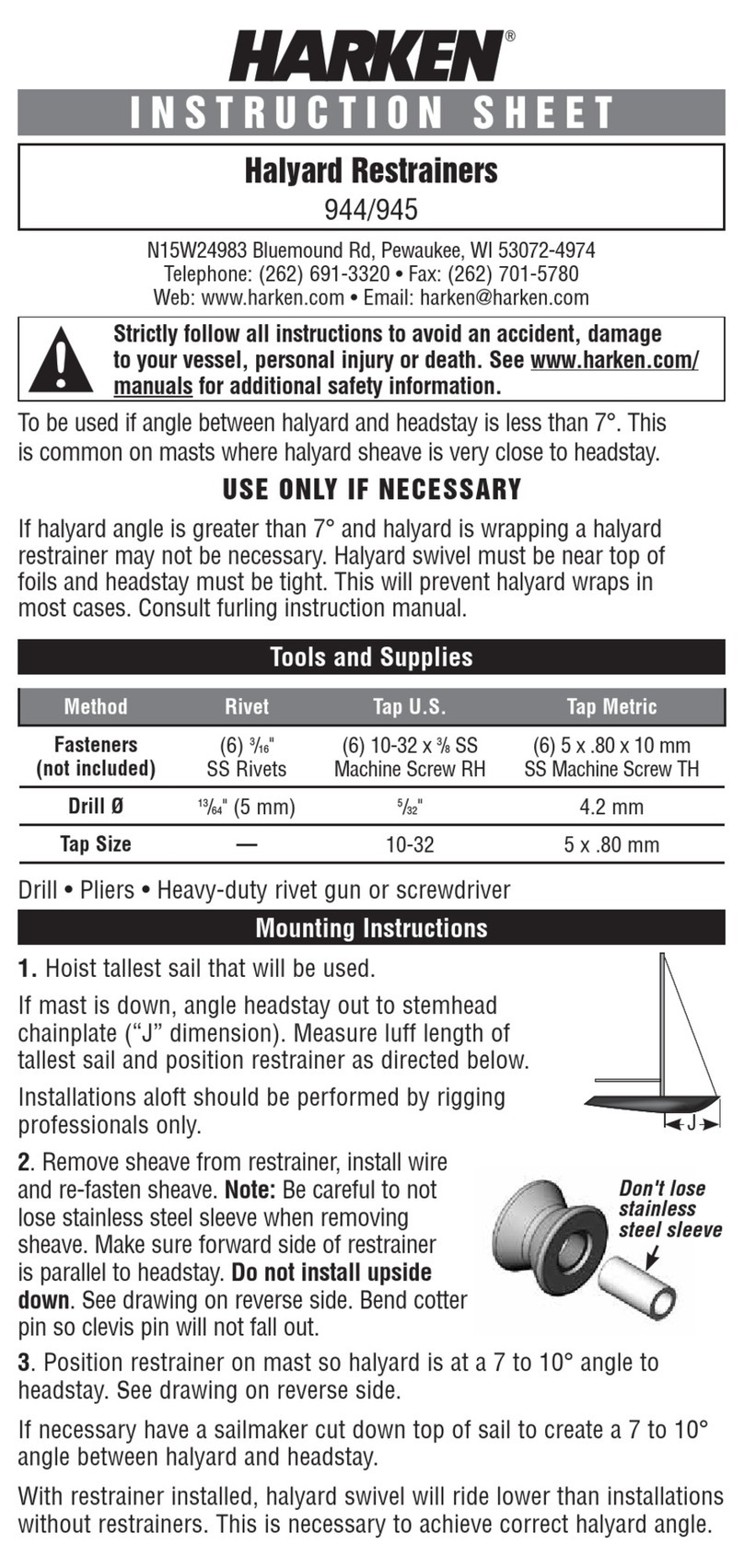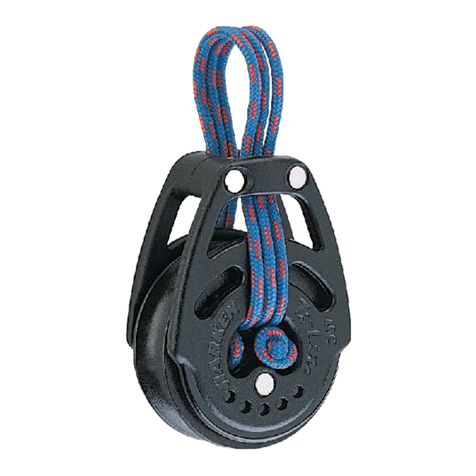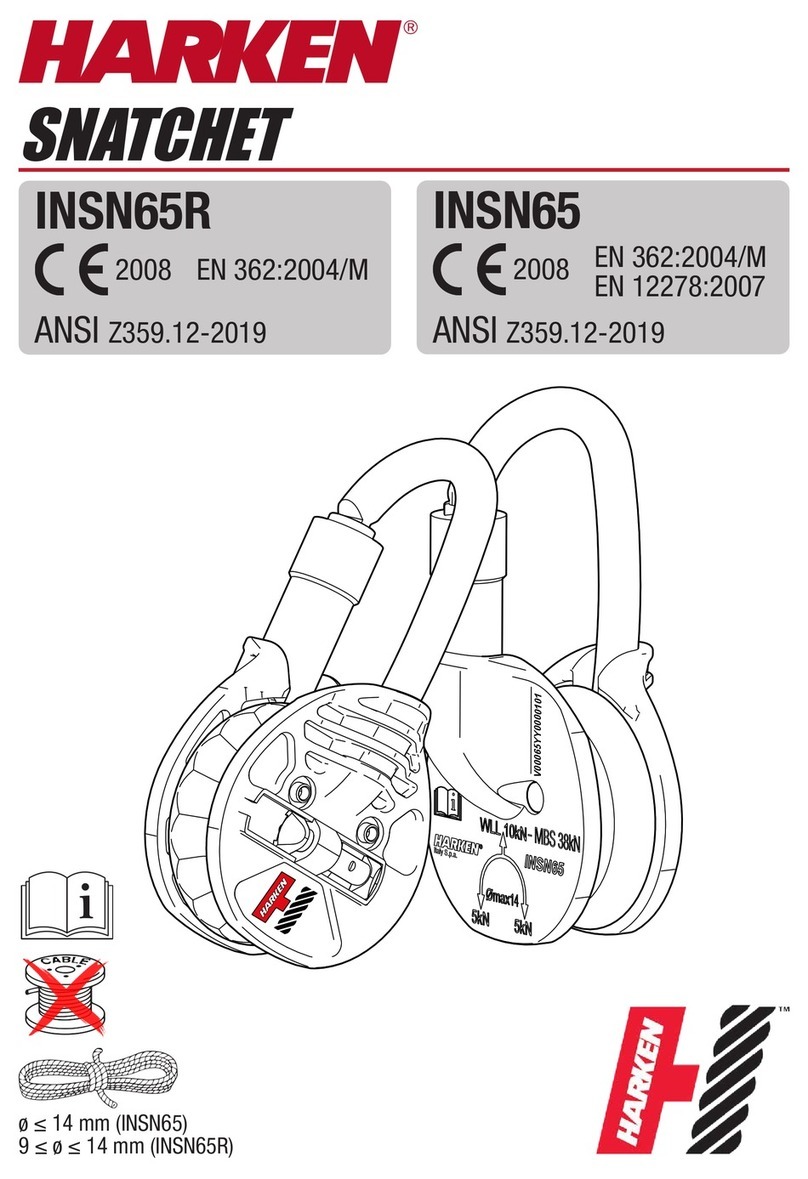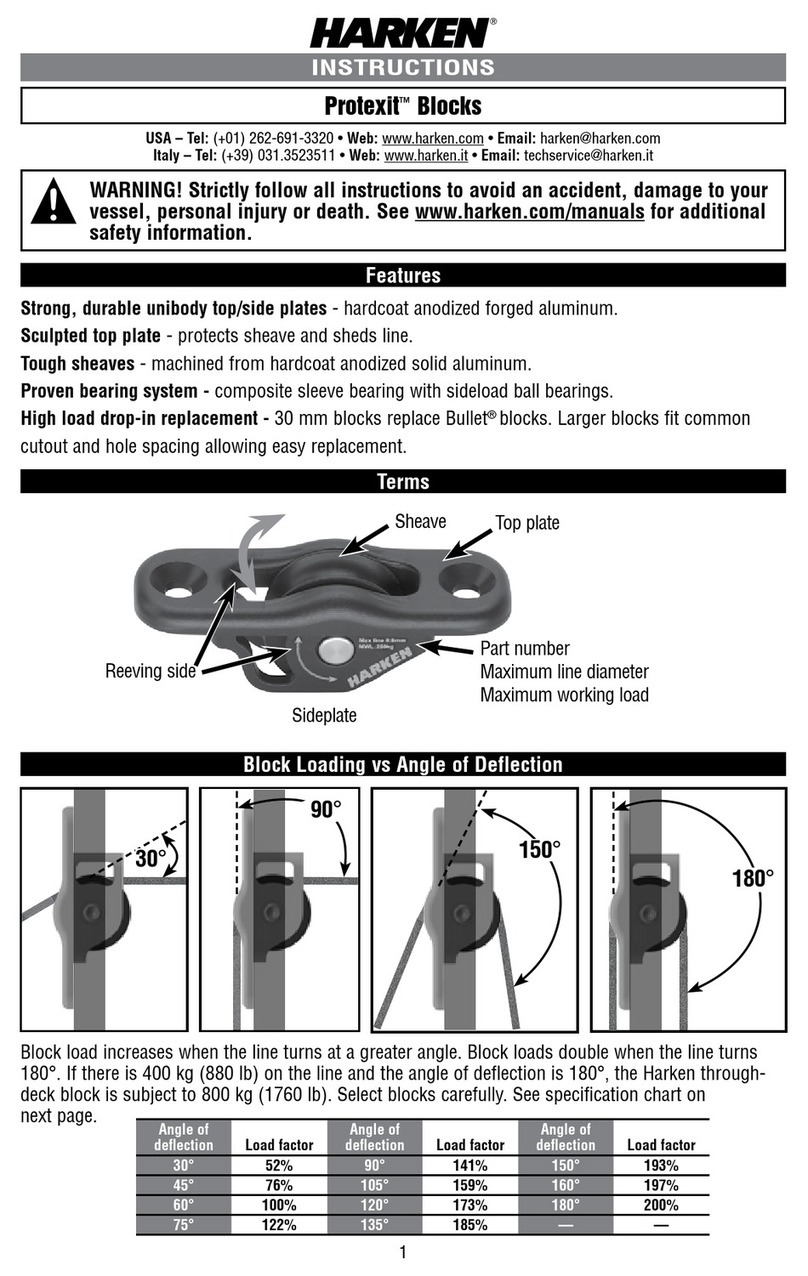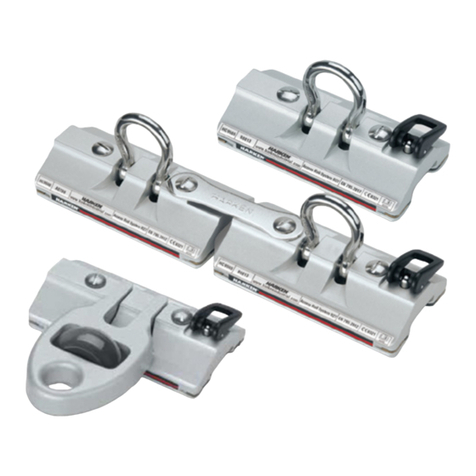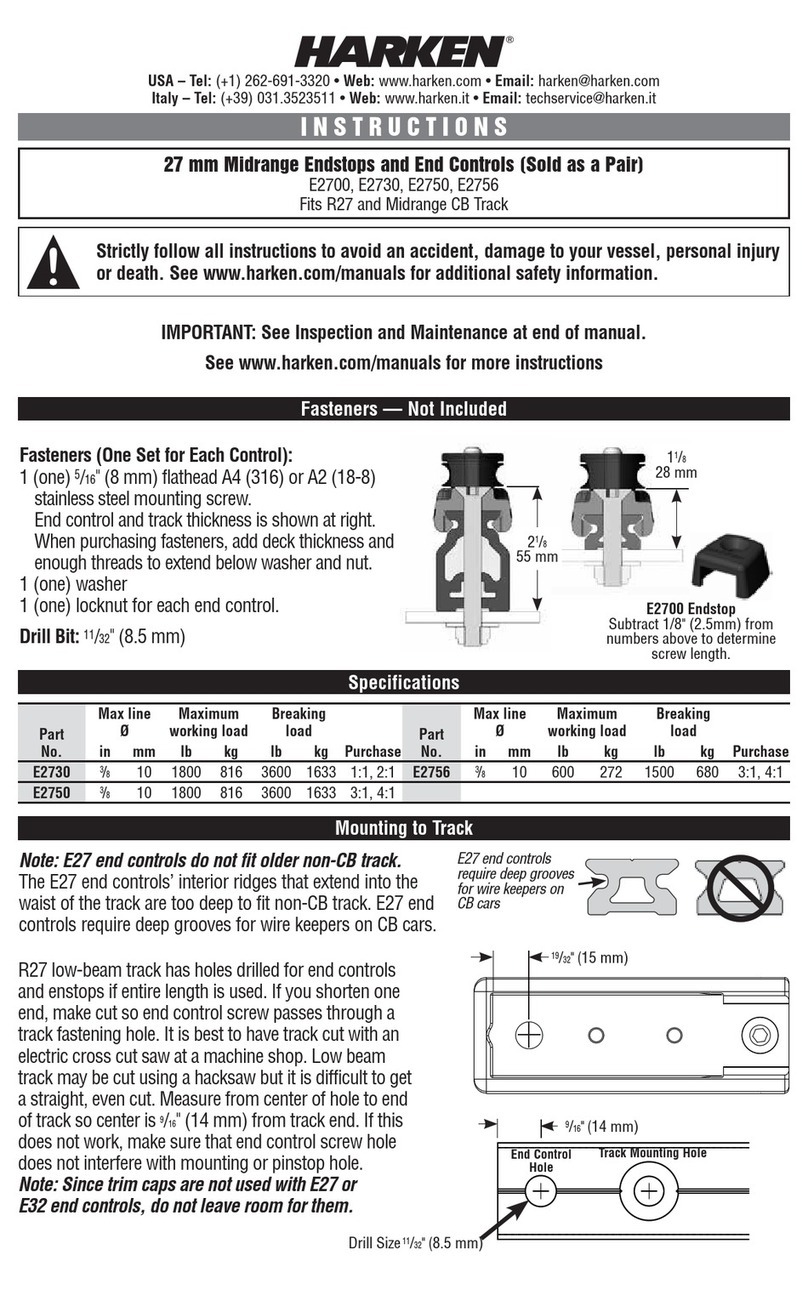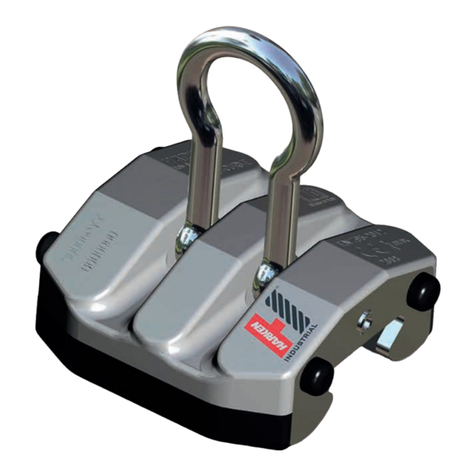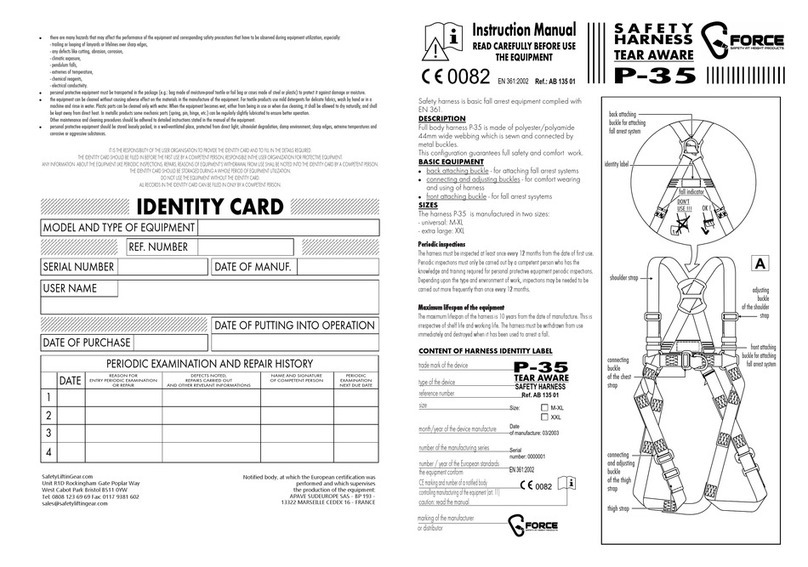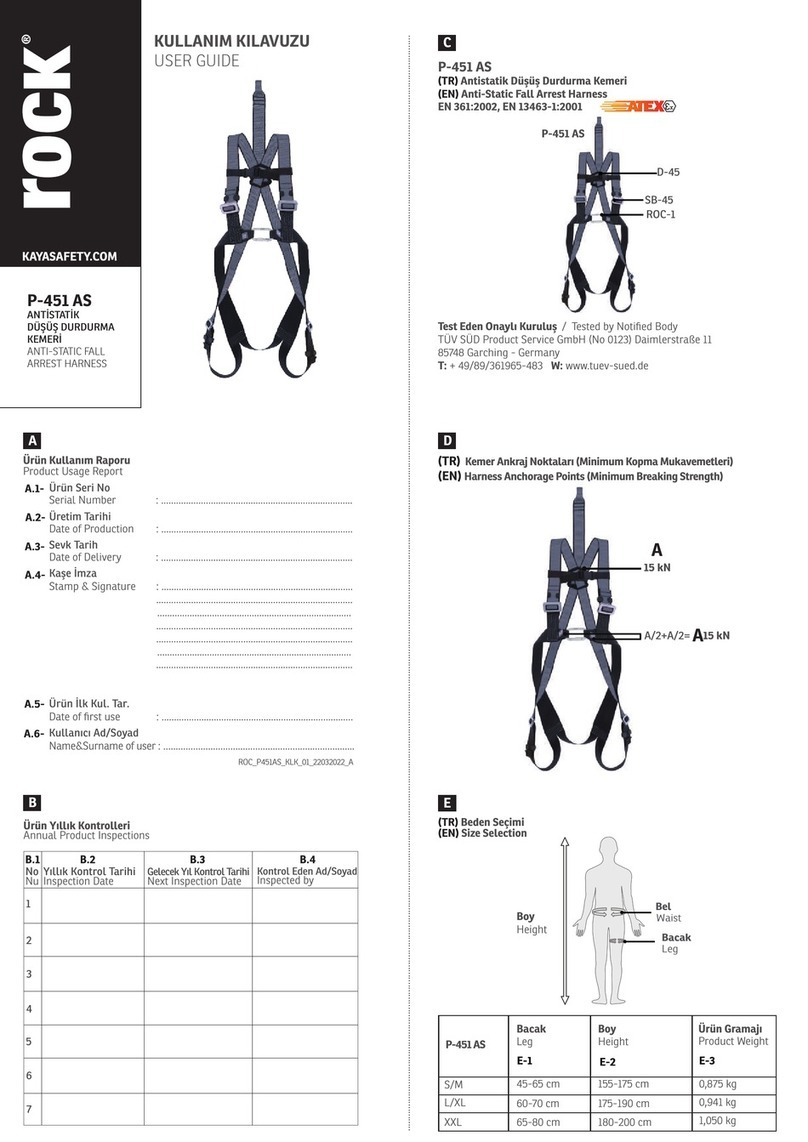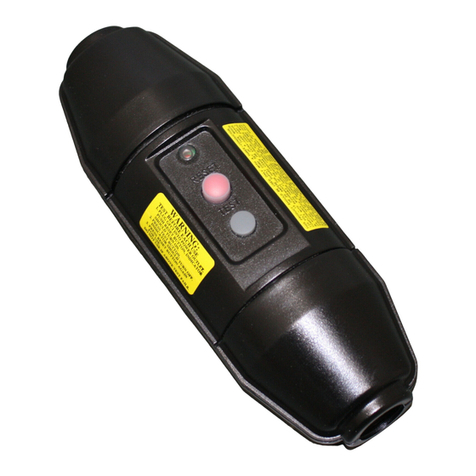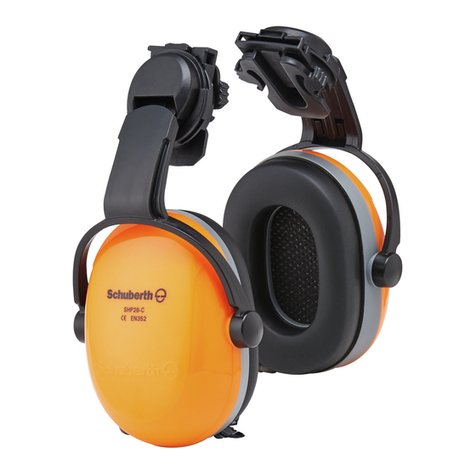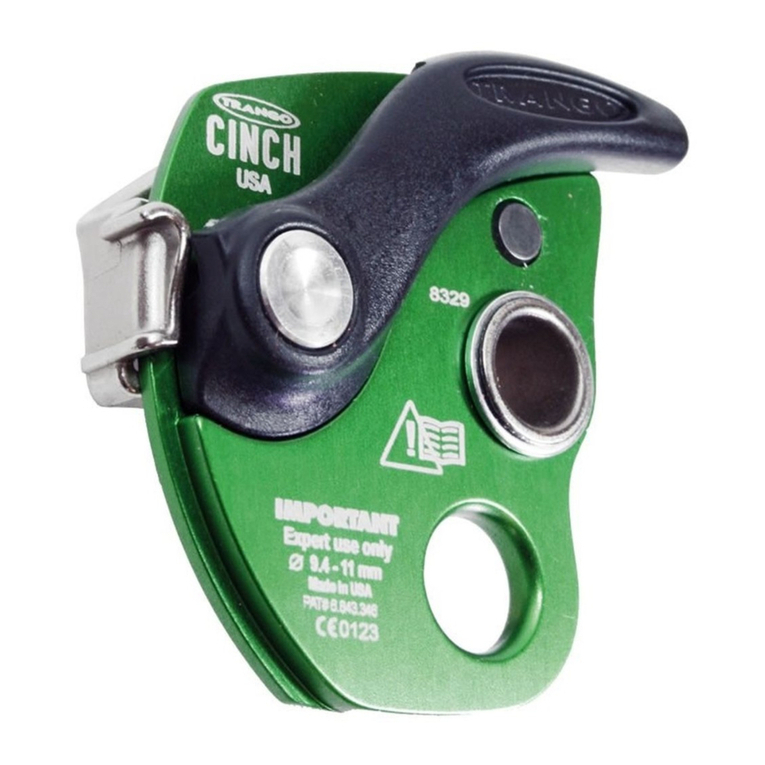
Field of Application
Before using the HarkenNinjaMultiAscend, read the instructions contained
in this manual thoroughly. This instruction manual is an integral part of the
product, and it supplies information for its correct safe use and maintenance.
If you do not understand any of the instructions, please contact Harken’s
authorizeddealer. Harken shall not be liable for damages, injuries, or
death caused by usage not covered in this manual or any non‑compliant or
unsafeactions.
This manual is intended for specialized personnel or expertusers.
Safety Information
General advice
Progress capture device for ascending rope, and short distance
ropedescents.
Intended use
• As a typeB rope adjustment
device compliant to the European
StandardEN12841:2006 (fully
rated and lockingchestascender)
up to a maximum ratedload of
140kg, that is a manuallyoperated
device which, when attached to
a workingline, locks under load
in one direction and slides freely
in the opposite direction, to be
used on ropeaccess systems and
relatedactivities.
• This product can be used for
haulingsystems: this use is to be
considered outside the scopes of
the Regulation2016/425.
• This product should only be
used by one person at a time;
this equipment should be a
personalissueitem.
• This product is intended to prevent
the risk of falls from a height during
acceptableactivities.
• As a rope clamp compliant to the
EuropeanStandard EN567:2013
to be used on mountaineering
and related activities, that is
a mechanicaldevice which, if
attached to a rope or an accessory
cord of appropriate diameter,
will clamp under load in one
direction and move freely in the
oppositedirection.
Improper use
• Do not use with wirerope.
• Do not use as a fallarrest device.
• Do not use this product outside
of its limitations, or for any other
purpose than that for which it is
intended.
• Do not alter, tamper, or add
to this equipment without the
manufacturer’s prior written
consent. Any repair shall only be
carried out in accordance with the
manufacturer’sprocedures.
• Do not use this rope clamp in
weather or environmentalextremes.
Personal protective equipment
• Harness, gloves, and helmet
that meet national and/
or localrequirements are
recommended.
• Follow your national and/or
local regulatory requirements
for Personal Protective
Equipment(PPE).
Risks
• This equipment shall only be used
by a person trained and competent
in its safeuse.
• Activities involving the use of the
NinjaMultiAscend are inherently
dangerous. You are responsible for
your own actions and decisions.
• Read and understand all
instructions before use
• Get specic training on the
NinjaMultiAscend’s properuse.
• Become acquainted with
MultiAscend’s capabilities
andlimitations.
• Understand and accept the risks
involved.
• Users must be medically t for
all activities the MultiAscend is
involved in. Users must be capable
of controlling their own safety in any
emergencysituation.
• Failure to heed any of these
warnings could result in severe
injury ordeath.
• Overloading or dynamic load on the
NinjaMultiAscend may damage the
anchorrope.
• Verify that the product markings are
legible. Fig 4
WARNINGS
Do not use as a fall arrest device.
Anchor ropes should be attached to the anchor above the user.
Slack between the anchor and the user should be avoided.
Any loading above the published recommendations or dynamic
loading on the MultiAscend may damage both the rope and the
device. Stay within the limitations of the specifications and
lengths documented.
Only competent personnel trained to use this equipment safely
may use it.
Be aware of any dangers that may occur due to the use of
combined items, in which the safe function of any one item is
affected by, or interferes with, the safe function of another.
Do not trail or loop this product over sharp edges. Trailing or
looping safety equipment in such a way may result in death
or injuries.
Do not make any alteration or additions to the equipment
without Harken’s prior written consent. All repairs should only
be carried out according to Harken procedures.
If the product is sold outside of its original country of
destination, the reseller must provide instructions for the
following: use, maintenance, periodic examination, and repair,
in the language of the country where the product is to be used.
Product descriptions/components
Materials: The product is made of aluminum body andswing plate; stainless
steel hardware, pawls, and harness connection; nylonwebbing for the strap;
stainless steel for the metal components of the strap.
Dimensions - Fig 2
Fig 1
YYYYDDD-XXXX
6
7
8
9
2008
EN12841: 2006-B
Ø11 -13 mm
140kg
EN567: 2013
Ø9 -13mm
1
4
5
2
3
Fig 4
Nomenclature of parts - Fig 5
A. Top adjustment strap
B. Swing plate
C. Latch
D. Pawls
E. Capscrew
F. Bottom saddle bracket
G. Pawl triggers
H. M4 Tapped hole*
I. Body
J. Cotter ring
K. Nylon insert locknut
*for optional locking fastener
swingplate
Certifications
The MultiAscend device complies with regulation (EU)2016/425 relating
toPPE.
EN567:2013 ‑ 9–13mm rope
Tested for certication purposes with the following models ofrope:
Tendon Canyon Dry Ø9mm
Bluewater Protac Ø9mm
Tendon Static Ø9mm
Teufelberger KMIII Ø9mm and Ø13mm
EN12841.2006 B ‑ Ø: 11–13mm, maximumrated load:140kg
Tested for certication purposes with the following models of rope (both
lowstretch kernmantel ropes according to EN1891, typeA):
Beal Access Ø11mm
Teufelberger KMIII Ø13mm
Note: This product has been approved for the use under the following
specic conditions, as indicated in the standard EN12841:2006: heat, cold,
wet, andoil.
Note: When the adjustable anchor line is loaded by the full weight of the
user this becomes a working line and an independently anchored safety line
should be used in addition for optimum safetyoftheuser.
Note: The primary function of TypeB rope adjustment devices is progression
along the working line, and they shall always be used in conjunction with,
and connected to, a TypeA rope adjustment when used in accordance with
EN12841:2006.
Note: When used as a rope adjustment device compliant with EN12841,
only low stretch TypeA kernmantle ropes compliant with EN1891 shall be
used. When used as a rope clamp compliant with EN567:2013, the device
can be used with any of the following options:
• Dynamic mountaineering ropes compliant to EN892
• Accessory cords compliant to EN564
• Low stretch kernmantle ropes compliant with EN1891
Note: The harness must be compliant with EN813 or EN12277.
Note: It is recommended to use this device only in conjunction with
CE‑markedPPE for compliance with2016/425.
The EU examination certicate and production control phase were carried
out by DolomiticertS.C.A.R.L. EUNotiedBody (N.B.2008, Villanova Zona
Industriale7/A, 32013Lonarone(BL)— Italy‑Tel.+390437573407).
The EUDeclaration of Conformity can be downloaded from the website
www.harken.com.
This manual can be changed without notice.
Consult the website for updated versions or other languages not in
thismanual.
Product labeling Fig 4
1. CE mark and number of the
notied body involved in the
control of the production
2. Certication information regarding
EN12841:2006
3. Certication information regarding
EN567:2013
4. Latch open direction
5. Correct loading direction
6. Manufacturer’s part number
7. Name and address of
manufacturer
8. Read the manual
9. Serial number of device
Unit Serial Number
Control
Day of Manufacture
Year of Manufacture
The Serialnumber is in the format YYYYDDD‑XXXX. Thisformat represents
the following: 4‑digityear, 3‑digitday (Julian calendar count), and a 4‑digit
individual identier. For example, in the Juliancalendar, the number234
represents August22.
Use
Connection to the harness: Connect the bottom saddlebracket to
an approved, rated, full‑strength point on the harness’ ventral (frontal)
attachmentFig 15. The MultiAscend is considered a full point of attachment
when properly connected to a full bodyharness:
1. Loop bottom saddle bracket
through harness.Fig 11
andFig 12
2. Screw in capscrew until lock
nut is tight. Capscrew andnut
should turn together free from
base.Fig 13
3. Loop cotterring in hole of
capscrew.
4. Connect upper webbingstrap
to sternal D‑ringconnection of
harness to hold up when not in
use.Fig 14
WARNING! Not all harnesses are compatible with this chest
ascender. Consult manufacturer for recommendations.
WARNING! Only use lock nut once, then replace.
WARNING! When using the MultiAscend as a chest ascender,
never connect the chest ascender to the harness attachment
point via an additional component (e.g., a connector or a
lanyard). Always connect the saddle bracket directly to the
harness attachment point.
Top adjustment strap
Attach as an alignment support per harness instructions. See Fig 1 diagram
of strap reeving. Ensure that the top adjustment strap cannot get caught in
thepawls.
WARNING! Strap not for load bearing, only for
alignment purposes
B
C
D
I
A
G
H
E
F
J
K
Fig 5
Harken Inc., USA - One Harken Way, N15W24983 Bluemound Rd., Pewaukee, WI 53072, USA M1033 10/23 Made in USA Printed in USA
Replacement parts
Part no. Description
IN909 Pin, bottom saddle bracket, lock nut and cotter ring
IN910 Webbing strap replacement
IN909
IN910
Fig 3
40 mm
1.59"
120 mm
4.74"
DirectionDirection
ofof
TravelTravel
73 mm
2.87"
148 mm
5.84"
108 mm
4.25"
Fig 2
